Abstract
Objective: To report the novel use of acellular dermal matrix allograft to treat a complex open fracture of the arm. Methods: Case report outlining the steps taken to treat the fracture and soft tissue trauma. Results: The complexity of the wound required multiple types of treatments that ultimately resulted in a healed fracture and full wound closure. Conclusions: Acellular dermal matrix has shown promise in closing the wound of a complex open fracture within the limitations of a single patient case study.
Keywords: Acellular dermal matrix, fracture, wound, DermACELL
Introduction
Fractures in the radius or ulna of the arm can occur from accidents where trauma may cause complex bone and soft tissue damage. Deep wounds can expose the tendons in the arm which risk damage to normal arm and hand function [1]. Damage to the ligaments, especially the scapholunate ligament, is also a frequent complication [2]. Nerve damage from distal radius fractures is not uncommon with median nerve damage occurring much more frequently than ulnar nerve injury [3,4]. Surgical intervention is often required but may be difficult to perform safely in more complicated cases, risking further nerve and ligament damage [5]. Additionally, close proximity of the wound to large blood vessels can make hemorrhaging a concern with microsurgery. After the fracture is repaired, the soft tissue wound must still be closed. Although in the past less focus was given to the soft tissue repair step, long-term substandard results demand a greater role in soft tissue treatment [5]. Staples, stitches, or dressings may be satisfactory for smaller defects; however, larger sized wounds may require an additional protective covering. Autograft skin, often harvested from the patient’s thigh, has resulted in satisfactory outcomes but causes additional patient pain and wound morbidity. An alternative treatment is to use allograft dermis that has been decellularized.
Acellular dermal matrix (ADM) can serve to protect the wound while allowing the patient’s own cells to incorporate into the wound bed, eventually resulting in full wound closure. ADMs have successfully been used for wound closure in diabetic foot ulcers [6-8], scar tissue resurfacing from burn wounds [9], and breast reconstruction [10,11]. One particular ADM, DermACELL®, undergoes a process [12] which results in terminal sterility and ≥ 97% reduction in DNA content while still providing a biocompatible scaffold [13] for healing [6,9,10,11,13]. Although there is a long clinical history of using ADMs in a wide variety of medical procedures, the authors believe this is the first published technique of using DermACELL in the treatment of a complex arm fracture.
Case
The patient was a male in his thirties who received a complex trauma wound caused by a mushroom collecting machine. His hand got caught in the machine, which caused an open fracture in his left arm, together with soft tissue trauma and exposure of the tendons in the wound bed.
The patient underwent surgery for internal fixation of the fracture. Then the soft tissue wound was treated locally with wet dressing and afterwards was connected to a VAC machine. While the patient was a candidate for microsurgery, there was a concern of damage to the large blood vessels in the hand due to the trauma, so it was decided that the patient would instead undergo a second operation to shorten the radial bone and close part of the open wound. After undergoing this operation, the wound was treated with vacuum therapy every four days in order to narrow the wound margins and achieve granulated tissue (Figure 1).
Figure 1.
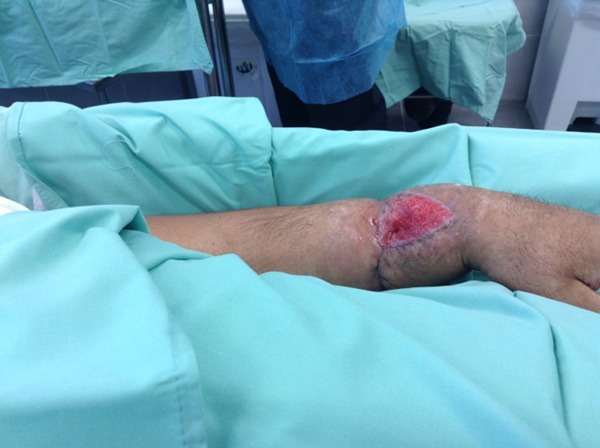
Open soft tissue wound before DermACELL application.
Two months after the wound was received, the patient underwent DermACELL (LifeNet Health, Virginia Beach, VA, USA) implantation according to the instructions for use (Figure 2). The first wound change took place after five days, where DermACELL appeared to begin incorporating into the wound bed (Figure 3). Follow-up continued at the clinic every week for observation and dressing change (Figure 4). The staples were pulled out after three weeks (Figure 5). The wound margins steadily narrowed (Figure 6) until full wound closure was achieved after six weeks (Figure 7).
Figure 2.
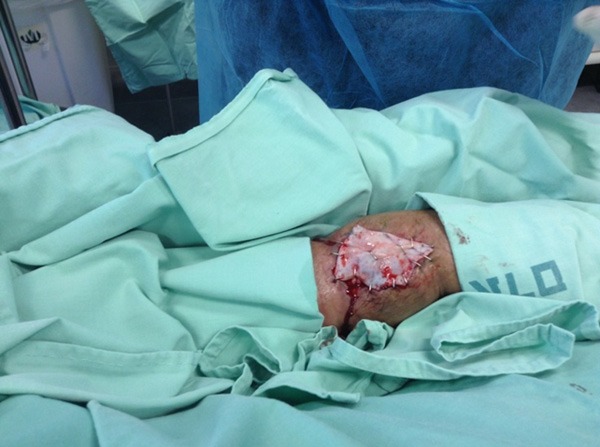
DermACELL is implanted two months following initial trauma.
Figure 3.

DermACELL showed signs of early incorporation five days following implantation at the first dressing change.
Figure 4.
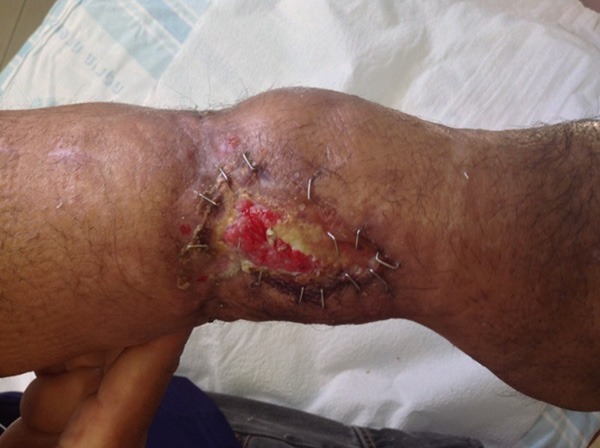
The ADM continued to show signs of incorporation two weeks following implantation.
Figure 5.
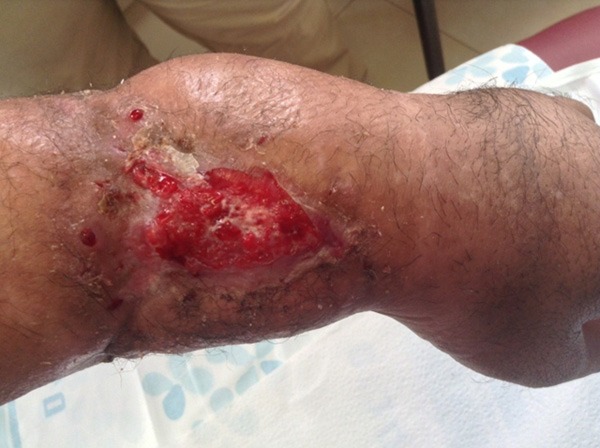
The staples were removed at three weeks post ADM implantation.
Figure 6.
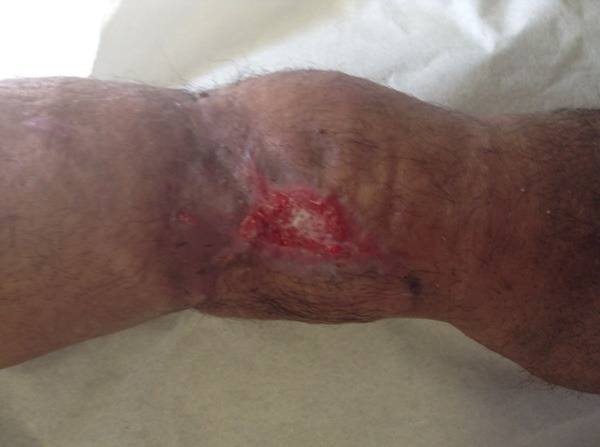
The wound started showing significant closure and ADM incorporation by four weeks post-implantation.
Figure 7.

The wound has fully closed by six weeks post-implantation.
Discussion
Despite the complexity of the trauma wound, the ADM was able to incorporate and fully close the wound by six weeks post-implantation. The wound began healing slowly initially but the wound margins began rapidly narrowing by three weeks post-implantation with wound closure attained at six weeks. This timeline for wound healing is comparable to the 30 days needed to achieve wound healing in a related case using DermACELL to provide wound resurfacing in burn patient [9]. There were no signs of infection nor did the patient experience any apparent immune response to the allograft. The ADM was able to provide protection for the wound while encouraging rapid healing without the disadvantages of donor site morbidity and increased patient pain for autografts. While the results of this case study are not generalizable, the rapid wound closure was encouraging and supports further use of this ADM for treating soft tissue trauma wounds.
Disclosure of conflict of interest
Dr. Bertasi is a consultant for LifeNet Health but has received no compensation directly related to the study reported here. The authors report no further conflicts of interest.
References
- 1.Ovidiou A. Management of complication of distal radius and ulna fractures. J Bone Joint Surg Br. 2002;84:358–9. [Google Scholar]
- 2.Ogawa T, Tanaka T, Yanai T, Kumagi H, Ochiai N. Analysis of soft tissue injuries associated with distal radius fractures. BMC Sports Sci Med Rehabil. 2013;5:19. doi: 10.1186/2052-1847-5-19. [DOI] [PMC free article] [PubMed] [Google Scholar]
- 3.Cho CH, Kang CH, Jung JH. Ulnar nerve palsy following closed fracture of the distal radius: A report of 2 cases. Clin Orthop Surg. 2010;2:55–8. doi: 10.4055/cios.2010.2.1.55. [DOI] [PMC free article] [PubMed] [Google Scholar]
- 4.Wilson C, Aragon A, Smith A. Ulnar nerve palsy following closed radiocarpal fracture-dislocation. Am J Orthop. 2008;37:E138–40. [PubMed] [Google Scholar]
- 5.Smith D, Henry M. Comprehensive management of soft-tissue injuries associated with distal radius fractures. J Hand Surg Am. 2002;2:153–64. [Google Scholar]
- 6.Yonehiro L, Burleson G, Sauer V. Use of a new acellular dermal matrix for treatment of non-healing wounds in the lower extremities of the diabetic patient. Wounds. 2013;25:340–344. [PubMed] [Google Scholar]
- 7.Winters C, Brigido S, Liden B, Simmons M, Hartman J, Wright M. A multicenter study involving the use of a human acellular dermal regenerative tissue matrix for the treatment of diabetic lower extremity wounds. Adv Skin Wound Care. 2008;21:375–81. doi: 10.1097/01.ASW.0000323532.98003.26. [DOI] [PubMed] [Google Scholar]
- 8.Randall K, Booth B, Miller A, Russell C, Laughlin R. Use of an acellular regenerative tissue matrix in combination with vacuum-assisted closure therapy for treatment of a diabetic foot wound. J Foot Ankle Surg. 2008;47:430–3. doi: 10.1053/j.jfas.2008.04.012. [DOI] [PubMed] [Google Scholar]
- 9.Chen SG, Tzeng YS, Wang CH. Treatment of severe burn with DermACELL®, an acellular dermal matrix. Int J Burns Trauma. 2012;2:105–9. [PMC free article] [PubMed] [Google Scholar]
- 10.Vashi C. Clinical Outcomes for breast cancer patients undergoing mastectomy and reconstruction with use of DermACELL®, a new acellular dermal matrix. Plast Surg Int. 2014;2014:704323. doi: 10.1155/2014/704323. [DOI] [PMC free article] [PubMed] [Google Scholar]
- 11.Ortiz JA. The use of decellularized human dermal allograft for Poland’s breast reconstruction. Mil Med. 2014;179:e249–52. doi: 10.7205/MILMED-D-13-00276. [DOI] [PubMed] [Google Scholar]
- 12.6,743,574; 6,734,018 United States Patents.
- 13.Qin X, Cotter A, Chen S, Chen J, Wolfinbarger L. Gamma-irradiated human acellular dermis: a potential treatment for wound and soft tissue defects. Society for American Wound Care. 21st Annual Mtg. Apr 24-27, 2008. [Google Scholar]


